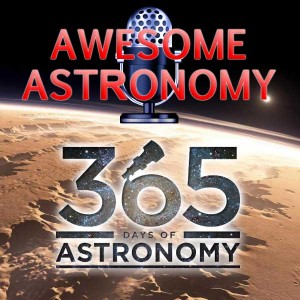Podcaster: Ralph & Paul
 Title : Awesome Astronomy’s June 2015
Title : Awesome Astronomy’s June 2015
Organization: Awesome Astronomy
Link : www.awesomeastronomy.com
Description: Awesome Astronomy June Discussion
Bio: Awesome Astronomy is the show for anyone and everyone who has even the slightest interest in astronomy and science.
Join Ralph & Paul twice each month, for informative and fun astronomy programs telling you what to look out (and up) for every month. You can be guaranteed a passion for astronomy, simple explanations of complex and fundamental topics, space and science news, absorbing interviews with astronomers who make the news and listeners’ astronomy questions answered
Today’s sponsor: This episode of “365 Days of Astronomy” is sponsored by — no one. We still need sponsors for many days in 2015, so please consider sponsoring a day or two. Just click on the “Donate” button on the lower left side of this webpage, or contact us at signup@365daysofastronomy.org.
Transcript:
The Discussion: A cloudy but fun-filled AstroCamp dominates the discussions this month with glimpses of the planets and a hurried Messier Marathon in between gaps between the clouds. Nick Howes’ talk inspires reflections on the threat of asteroids and comets and how amateur astrophotographers can contribute to science.
The News: This month we take a look at NASA’s new draft 2015 Technologies Roadmap and discuss the advances in robotics, space propulsion, power transfer and nanotechnology that NASA hope to seed. Next up is some research from NASA’s Jet Propulsion Laboratory that suggests the discolouration on Europa’s surface might be irradiated salt from the moon’s subsurface ocean. Finally, we take a look at the discovery, using ESO’s VLT, that globular clusters in the Centaurus A galaxy are far heavier than they should be – perhaps harbouring vast amounts of dark matter.
The 5 Minute Concept: Just a hundred years after Newton’s notion of Universal Gravitation, John Mitchell proposed an idea so futuristic that it was barely even noticed until Einstein showed the universe has space-time geometry. Then, in 1972, the predictions of Newton, Einstein and Mitchell were revealed as the mind-bending reality of black holes.
The Interview: This month we welcome back Dr Joe Liske from the European Southern Observatory to talk about the New Technologies Telescope that tested new ways to build ever larger telescopes and paved the way for the monster observatories we see today.
Q&A: Listeners’ questions via email, Facebook & Twitter take us on a journey into the astronomy issues that have always plagued our understanding or stretched our credulity. This month Ralph & Paul answer:
- If there is life elsewhere in the solar system, where do you think it is most likely to be? Louisa Martin, Brisbane Australia, via email
End of podcast:
365 Days of Astronomy
=====================
The 365 Days of Astronomy Podcast is produced by NUCLIO. Audio post-production by Richard Drumm. Bandwidth donated by libsyn.com and wizzard media. You may reproduce and distribute this audio for non-commercial purposes. Please consider supporting the podcast with a few dollars (or Euros!). Visit us on the web at 365DaysOfAstronomy.org or email us at info@365DaysOfAstronomy.org. This year we celebrate cosmic light as light is our info messenger in the universe. Join us and share your story to celebrate the International Year of Light. Until tomorrow! Goodbye!

